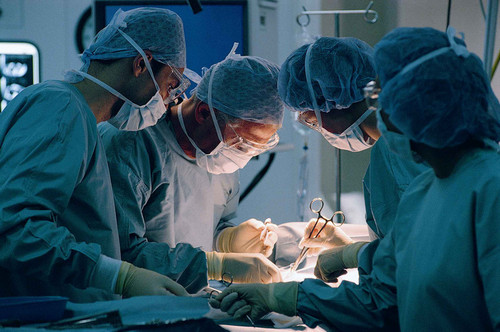The most common complaint of headache occurs only with a sharp increase in blood pressure in cases of hypertensive encephalopathy and in malignant arterial hypertension.
Increased blood pressure may be accompanied by dizziness, nosebleeds and weakness. However, these complaints are quite often encountered at a normal level of blood pressure.
Complaints related to the underlying disease in cases of symptomatic arterial hypertension include severe muscle weakness, polydipsia and polyuria in primary hyper aldosteronism, arthralgia, weight loss and fever with periarteritis nodosa.
Symptoms of high blood pressure are not specific.
Symptoms of arterial hypertension-induced vascular lesions include blurred vision, intermittent weakness and dizziness due to transient ischemia of the central nervous system, hematuria and nocturia. Angina may occur due to accelerated development of atherosclerosis, severe chest pain during aortic dissection, shortness of breath and other signs of acute and chronic heart failure. Myocardial infarction and stroke are also possible.
Arterial hypertension, as defined by the WHO Expert Committee, is a constantly increased systolic and / or diastolic pressure.
Essential hypertension (primary hypertension or hypertension) is high blood pressure in the absence of a probable cause of its increase.
Secondary hypertension (symptomatic) is hypertension, the cause of which can be identified.

According to the latest recommendations of the WHO and the International Hypertension Community (1999), several levels of arterial hypertension are identified.
According to this classification, arterial hypertension is an increase in systolic blood pressure up to 140 mm Hg. Art. and higher or diastolic arterial pressure up to 90 mm Hg. Art. and above, if such an increase is stable, i.e. confirmed during repeated measurements of blood pressure (at least 2-3 times on different days for 4 weeks).
|
Categories
|
Systolic blood pressure, mm Hg.
|
Diastolic blood pressure, mm Hg.
|
|
Optimal
|
<120
|
80
|
|
Normal
|
<130
|
85
|
|
High normal
|
130-139
|
85-89
|
|
Hypertension:
1 degree (mild arterial hypertension)
|
140-159
|
90-99
|
|
subgroup: borderline
|
140-149
|
90-94
|
|
II degree (moderate arterial hypertension)
|
160-179
|
100-109
|
|
III degree (severe arterial hypertension)
|
> 180
|
> 110
|
|
Isolated systolic hypertension
|
> 140
|
<90
|
|
subgroup: borderline
|
140-149
|
<90
|
Classification of arterial hypertension for an etiological approach (WHO, 1996 p.):
-
Renoparenchymatous hypertension.
-
Renovascular hypertension.
-
Hypertension after kidney transplantation (post-transplant hypertension).
-
Pheochromocytoma.
-
Primary mineralocorticoidism:
-
primary hyper aldosteronism;
-
deoxycorticosterone-producing tumor;
-
-
adrenogenital syndrome (congenital adrenal hyperplasia).
-
Glucocorticoidism: Cushing syndrome.
-
primary hyperrenism.
-
Acromegaly.
-
Hyperpathiroididism.
-
Endothelin-producing tumor.
-
Hypo-and hyperthyroidism.
-
Menopausal hypertension.
-
Diabetic kidney damage.
-
Pre-eclampsia / eclampsia.
-
Pre-eclampsia on the background of existing chronic hypertension.
-
Transient hypertension.
-
Coarctation of the aorta.
-
Systolic cardiovascular hypertension:
-
-
hyperkinetic syndrome;
-
aortic insufficiency;
-
aortic sclerosis;
-
severe bradycardia (with atrioventricular blockade III degree);
-
arteriovenous shunts, uninflated arterial (Batalov) duct.
-
Hypertension associated with drugs and other substances (drug hypertension):
-
Oral contraceptives.
-
Carbenoxolone (pseudoaldosteronism).
-
Therapy with glucocorticosteroids in large doses (pseudo-tuberous syndrome).
-
Erythropoietin.
-
Ciclosporin.
-
Alcohol
-
Hypertension caused by neurological damage.
-
Brain concussion.
-
Sleep apnea syndrome.
The main tasks of the clinical, laboratory and instrumental examination of a patient with arterial hypertension at the EUROLAB medical clinic are:
-
detection of secondary (symptomatic) arterial hypertension, which is potentially treatable;
-
clarification of the nature and severity of individual manifestations and complications of the disease that are important when prescribing treatment;
-
identification of risk factors for diseases associated with atherosclerosis.
Complaints
Most patients have no complaints and an increase in blood pressure is detected only when it is measured.
Complaints may be related to:
-
high blood pressure;
-
vascular lesion due to arterial hypertension;
-
the main disease in cases of symptomatic hypertension.




Hey I know this is off topic but I was wondering if you knew of any widgets I could add to my blog that automatically tweet my newest twitter updates.
I’ve been looking for a plug-in like this for quite some time and was hoping maybe you would have some experience with something like this.
Please let me know if you run into anything.
I truly enjoy reading your blog and I look forward to your new updates.
It抯 actually a nice and helpful piece of information. I抦 glad that you shared this useful info with us. Please keep us up to date like this. Thank you for sharing.